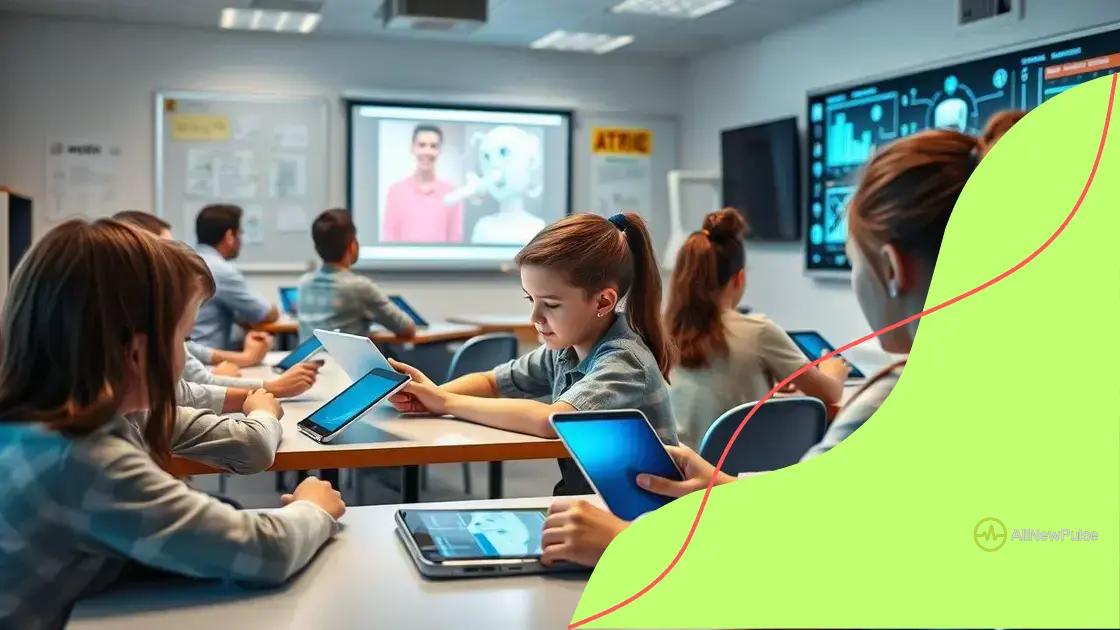The impact of artificial intelligence on educational tools

The impact of artificial intelligence on educational tools includes personalized learning experiences, improved accessibility, and enhanced engagement through innovative technologies, all while addressing challenges like data privacy and equitable access.
The impact of artificial intelligence on educational tools is transforming how teachers and students interact. Have you ever wondered how AI can streamline learning processes or personalize education? In this article, we’ll dive into the ways AI tools are enriching the educational landscape.
Understanding artificial intelligence in education
Understanding artificial intelligence in education requires an exploration of how technology interacts with learning processes. With AI becoming increasingly prevalent, it’s essential to grasp its role in creating efficient educational environments.
What is Artificial Intelligence?
Artificial intelligence refers to the simulation of human intelligence in machines designed to think and act like humans. In education, this means utilizing algorithms to tailor learning experiences for students.
Applications of AI in Education
AI can enhance learning through diverse applications:
- Personalized learning: Adapts to individual student needs.
- Intelligent tutoring systems: Provides one-on-one support.
- Administrative tasks: Automates grading and scheduling.
These applications offload routine tasks for educators, allowing them to focus on teaching. Furthermore, AI’s ability to analyze data helps identify student weaknesses and suggest resources for improvement.
As we delve deeper into this technology, it’s vital to recognize that AI is not just a tool—it’s a partner in the educational journey. The insights gleaned from AI tools can inform teaching strategies, making lessons more engaging and effective for students.
The Role of Data in AI
The effectiveness of artificial intelligence hinges on data. By analyzing extensive amounts of information, AI can provide insights into learning behaviors and outcomes. This data-driven approach fosters better educational practices and informs curriculum development.
Challenges Ahead
While the benefits are significant, challenges exist. Concerns about data privacy and the digital divide must be addressed to ensure equitable access to AI-driven tools. Educators must be trained on how to integrate this technology effectively into their teaching.
In conclusion, understanding artificial intelligence in education is vital for adapting to a rapidly changing learning landscape. By embracing AI, we can unlock new potentials in teaching and learning, making education more accessible and personalized.
Benefits of AI educational tools
The benefits of AI educational tools are profound and transformative for both students and educators. These tools can create more effective and engaging learning experiences.
Enhanced Learning Experience
AI tools adapt to individual learning styles, ensuring that each student receives personalized support. This leads to a more productive classroom environment where students can thrive at their own pace.
Time-Saving for Educators
Teachers often face overwhelming workloads. By using AI, many administrative tasks, such as grading and tracking student progress, can be automated. This saves educators valuable time that can be redirected towards teaching and mentoring.
- Automated grading: Reduces time spent on evaluating assignments.
- Progress tracking: Offers real-time feedback for both students and teachers.
- Resource recommendations: Suggests learning materials based on student performance.
The integration of AI allows teachers to focus on developing creative lesson plans and fostering strong relationships with students without being buried in administrative duties.
Additionally, these tools make learning more accessible to diverse learners, including those with disabilities. AI-driven tools can provide support through tailored resources and assistive technologies that cater to all students’ needs.
Data-Driven Insights
AI educational tools gather and analyze vast amounts of data, providing insights into student performance. Educators can identify trends and adjust their teaching strategies accordingly. This data-driven approach empowers teachers to enhance their lessons and better meet the needs of their students.
As the use of AI educational tools continues to grow, it’s crucial for educators to remain involved in the integration process to ensure these tools are effectively utilized. By embracing these technologies, the educational landscape can evolve to support and inspire learners in new and exciting ways.
Examples of AI tools in the classroom

There are numerous examples of AI tools in the classroom that enhance teaching and learning experiences. These tools empower educators to deliver personalized instruction and engage students more effectively.
Intelligent Tutoring Systems
Intelligent tutoring systems, like Knewton and DreamBox, provide personalized feedback and support to students. They analyze students’ responses and adapt the difficulty of tasks based on individual progress. This ensures that each student can learn at their own pace, making complex subjects more accessible.
AI-Powered Assessment Tools
AI assessment tools, such as Gradescope, help teachers grade assignments quickly and accurately. These systems can recognize patterns in student responses and provide insights into common misconceptions. They save time and allow educators to focus on enhancing instruction.
- Automated grading: Streamlines the grading process.
- Feedback generation: Offers personalized comments for improvement.
- Data analysis: Identifies trends in student performance.
By leveraging these AI tools, teachers can not only improve their efficiency but also support students in achieving better understanding and mastery of subjects.
Virtual Learning Environments
AI is also integrated into virtual learning environments, such as Edmodo and Smart Learning Suite. These platforms facilitate collaboration among students and provide resources tailored to their learning needs. AI chatbots, for example, assist students with questions outside of class hours, ensuring they receive help when needed.
In addition to enhancing student interactions, AI tools offer rich analytics for teachers. This data allows them to adjust their teaching strategies and address any learning gaps proactively. With the help of AI-driven platforms, education becomes more engaging and interactive for everyone involved.
Language Learning Applications
Language learning applications like Duolingo and Rosetta Stone utilize AI to personalize lessons based on user performance. They adjust content to ensure learners remain challenged yet supported, making language acquisition fun and efficient.
In conclusion, incorporating AI tools in the classroom revolutionizes education by creating tailored learning experiences. These technologies benefit both students and educators, ultimately fostering a more dynamic and effective learning environment.
Challenges of integrating AI in education
The integration of AI in education comes with several challenges that stakeholders must address. Understanding these challenges is crucial for effectively implementing AI tools in classrooms.
Data Privacy Concerns
One major challenge is ensuring data privacy. Schools collect a lot of sensitive information from students, and it’s essential to protect this data from breaches. Educators must be aware of regulations like FERPA and GDPR, which set guidelines for handling student information.
Equity in Access
Another significant issue is the digital divide. Not all students have equal access to technology, which can widen educational disparities. To ensure all students benefit from AI tools, schools need to provide equitable access and training on how to use these technologies effectively.
- Technology infrastructure: Schools must invest in necessary infrastructure.
- Device availability: Providing students with the devices they need.
- Training for teachers: Educators need professional development to integrate AI successfully.
By addressing these equity issues, educators can create a more inclusive learning environment for every student.
Resistance to Change
Some educators may resist adopting AI technologies due to fear or lack of understanding. This resistance can hinder the advancement of AI in schools. It’s important to promote awareness and demonstrate the benefits AI brings to enhance teaching and learning experiences.
Ongoing professional development and open discussions about the advantages of AI tools can help reduce resistance. When educators feel supported, they are more likely to embrace innovative technologies and incorporate them into their practices.
Ethical Considerations
Ethical issues around AI in education must also be taken into account. There are concerns about bias in AI algorithms, which can result in unfair treatment of students. It’s vital to ensure that AI systems are trained on diverse data sets to avoid perpetuating existing biases.
Incorporating AI in education presents both challenges and opportunities. By recognizing and addressing these challenges, educators can create effective learning environments that enhance educational experiences while navigating the complexities of technology integration.
Future trends in AI for education
The future trends in AI for education are exciting and promise to reshape how we teach and learn. As technology continues to evolve, educators and students can expect significant changes in the educational landscape.
Personalized Learning Experiences
One key trend is the growth of personalized learning experiences. AI enables the development of adaptive learning systems that cater to each student’s unique needs. These systems can analyze student performance and adjust the curriculum accordingly, allowing learners to progress at their own pace.
Integration of Virtual Reality
Another emerging trend is the integration of virtual reality (VR) and augmented reality (AR) into classrooms. AI can create immersive learning environments that engage students more deeply. For instance, a history lesson might come alive through a VR simulation of ancient civilizations, making learning more tangible and enjoyable.
- Experience-based learning: Enhances understanding through practical application.
- Increased engagement: Captures students’ attention with interactive content.
- Collaboration opportunities: Facilitates group projects in virtual spaces.
As these technologies develop, they are likely to foster teamwork and creativity in ways traditional classrooms cannot.
Improved Data Analytics
The use of AI will also enhance data analytics in education. Institutions can gather real-time data on student progress and behavior. This information allows for better decision-making in teaching strategies and resource allocation. Educators will be able to identify struggling students earlier and provide tailored support based on their needs.
This data-driven approach ensures that no student falls behind, paving the way for a more equitable educational system.
Increased Accessibility
AI will play a crucial role in making education more accessible. Tools designed for students with disabilities, such as speech recognition and text-to-speech technologies, will improve learning opportunities for all. These advancements help create inclusive classrooms where every student has the support they need to succeed.
With the ongoing development of AI in education, we may also see enhanced teacher training programs that leverage AI-driven platforms for professional development. Teachers will gain insights into the latest teaching methods and technologies to improve their practice, ultimately benefiting their students.
The future of AI in education holds great potential. As these trends develop, they will not only change how we approach learning but also prepare students for a world that increasingly relies on technology and innovation.
FAQ – Frequently Asked Questions about AI in Education
What are the main benefits of using AI in education?
AI provides personalized learning experiences, enhances engagement through immersive technologies, and helps educators manage tasks more efficiently.
How does AI support students with disabilities?
AI tecnologias offer assistive tools, such as speech recognition and text-to-speech functionalities, ensuring that all students have access to learning opportunities.
What challenges does AI integration in education face?
AI integration faces challenges like data privacy concerns, the digital divide, and resistance from some educators who may fear change.
What trends can we expect in AI for education in the future?
We can expect increased use of personalized learning systems, the integration of virtual reality, enhanced data analytics, and improved accessibility for all learners.





